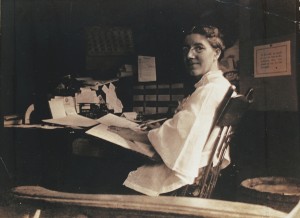By Karen Gavis/managing editor
While abundant rest may sound appealing, one 19th century feminist author says an overabundance could drive a woman insane.
The Literature of Prescription: Charlotte Perkins Gilman and “The Yellow Wall-Paper” will be displayed Aug. 26-Oct. 6 in the SE Campus library. The traveling exhibit was developed and produced by the National Library of Medicine and National Institutes of Health.

Photo courtesy National Library of Medicine
“It is easy to forget that just a little over a hundred years ago, some physicians thought too much education was detrimental to a young woman’s health,” said SE assistant director of library services Tracey Minzenmayer.
Gilman was actually treated with the rest cure — which the story’s narrator also undergoes — for what would probably be diagnosed today as postpartum depression, Minzenmayer said. The rest cure was prescribed for a variety of emotional disorders and involved complete bed rest, social isolation and prohibition against intellectual stimulation for women.
“After a few months, she rebelled and chose to end her marriage rather than continue with a treatment that was increasing her depression,” she said. “Writing ‘The Yellow Wall-Paper’ was her way to draw attention to the effects of the rest cure and ‘to save people from being driven crazy.’”
SE English professor Elizabeth Joseph loves the semi-autobiography, which she uses often in her English 1302 classes. Joseph said modern college students are amazed at how restricted women’s lives had been and how much control their husbands exerted over them.
“The narrator, although interested in writing, was not allowed to write,” she said. “The female readers of today sympathize with the narrator whose rights had been violated because of the patriarchal system.”
SE English instructor Yvonne Jocks uses the short story in her classes as well. Sometimes, she uses an audio version so students can better hear the narrator’s gradual descent into insanity, she said, such as when her sentences begin to lose structure or her topics become more internal.
“We talk about the prison symbolism in the children’s playroom to which the narrator is relegated – the bars on the windows, the rings on the walls that bring to mind manacles,” she said.
The class also works on putting the story into historical perspective, Jocks said. Future discussions might also include the topic of writing as therapy.
“I also like to discuss the root of the word hysteria, and the 19th century belief that women were more prone to insanity than were men, and some of the extremes to which they were subjected in attempted cures (including hysterectomies),” she said.
Minzenmayer said “The Yellow Wall-Paper” vividly illustrates the infantilization of women in the nineteenth century by the medical profession and their husbands. She thinks the exhibit will spur much discussion about what has changed as well as what has remained the same in the way society views women.
“Women are now actually in the majority on most college campuses,” she said. “The TCC student body is approximately 60 percent female.”























